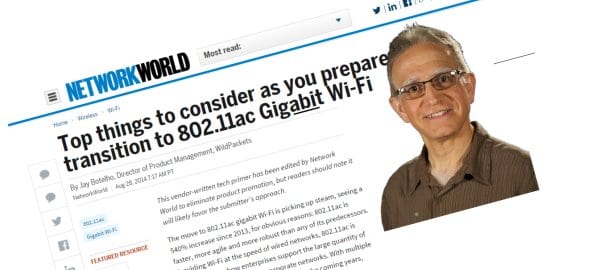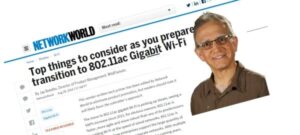Top Four Considerations For Transitioning to Gigabit 802.11ac Wireless

 Jay Botelho, Director of Product Management at WildPackets, the Walnut Creek, California-based network-performance and monitoring company has some advice for companies considering upgrading their WLAN system to 802.11ac on the network technology site Network World. They seem fairly common sense, but then again good sense can often not be so common. Because Botelho’s advice seems sound to me, I’ve paraphrased and quoted as necessary below to convey his wisdom. They are as follows:
Jay Botelho, Director of Product Management at WildPackets, the Walnut Creek, California-based network-performance and monitoring company has some advice for companies considering upgrading their WLAN system to 802.11ac on the network technology site Network World. They seem fairly common sense, but then again good sense can often not be so common. Because Botelho’s advice seems sound to me, I’ve paraphrased and quoted as necessary below to convey his wisdom. They are as follows:
1. Consider Your Options
This doesn’t just mean consider different vendors. It also means thinking about implementation options such as rip and replace versus “overlay,” where you add 802.11ac APs to your already existing WLAN architecture. There’s a great case to be made for the overlay method, according to Botelho:
If your network is like most enterprise networks, the bulk of your traffic is probably still in the 2.4GHz band, using the traditional b/g channels. Even if you’ve added 802.11n along the way, it’s most probably still heavily focused in the 2.4GHz band.
If this is the case, an overlay network is the way to go. Since 802.11ac only uses the 5GHz band, there will be little or no disruption to your current user base, and new clients with 802.11ac technology will immediately benefit from the new network. And, if you have clients that already support 802.11ac technologies (like the newer Macbooks) you will even see a benefit on your existing 2.4GHz network as these users will seamlessly migrate to the new 802.11ac network, freeing up bandwidth on the 2.4GHz channels.
Even if 70% of smartphones shipped in 2015 are 802.11ac capable, as predicted by ABI research, you’ll still need to handle all of those b/g/n devices on your network until you’re ready and/or able to replace them too, and in the meantime you can upgrade those older devices to 802.11ac if you really need to by investing in 802.11ac WLAN USB adapters.
Rip and replace can be more expensive up front than the overlay method, although your brand new network should still be able to handle older devices, as one of the radios standard on 802.11ac access points should be 2.4 GHz. Botelho does recommend that if you never really made the jump to 802.11n, rip and replace may make sense for you to finally get your network up to date. Nevertheless, understanding the financial implications of either strategy is a must for making your decision one way or another.
2. Do a Site Survey!
Some may see the time and money spent on consulting fees as a waste, but Botelho certainly doesn’t and I agree with him. Surveying your site is especially important if you’re considering 802.11ac because the new wireless standard uses a 5 GHz band. a good site survey will be able to tell you “what the 5GHz band looks like in your environment, helping you identify and avoid existing interferers, and make smart configuration choices for your new equipment.”
In Botelho’s words:
With all of the new features in 802.11ac, including some optional advanced features like beam-forming, the only effective way to truly take advantage of 802.11ac is to use a site survey to come up with a sensible WLAN design. You will converge on a design much more quickly, with the time savings more than paying for the cost of the survey.
3. Wired Upgrades Too?
With the rapidly increasing speed of wireless access points due to 802.11ac, and even more so when wave 2 rolls out, you may find that your wireless access point is no longer the bottleneck in your network. If you don’t have 1 Gigabit drops to your new AC APs, then you may not get the full benefit of going AC.
4. Monitoring Your Packets.
This is Botelho’s subtle plug for his own company’s solution set, but he nonetheless raises a good point. Formerly, Access Points and WLAN USB Adapters had similar capability for packet monitoring and analysis, especially in areas like encoding, data transmission and data rates. However, 802.11ac APs have far greater capability than AC clients or WLAN USB Adapters for this set of tasks. The result is that it can be very difficult to monitor and troubleshoot a network using an 802.11ac WLAN USB Adapter, as the “adapter will not capture, and will not even indicate in any way, that there is 802.11ac traffic that exceeds its data rate capabilities. This results in serious blind spots in network analysis and troubleshooting.” While the Network World article does not say how to solve that challenge, it strikes me as fairly obvious that Botelho’s company might have a few ideas.
For Botelho’s piece at Network World, click here.




















